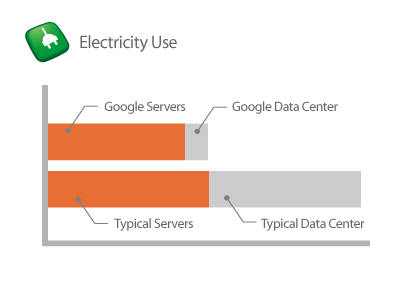Google says that each of its servers saves 500kWh of electricity a year, along with 1,000 gallons of water and 300 kg of carbon dioxide. That adds up to savings of $30 a year per server, although the company doesn't say how many servers it operates. The savings are focused in energy-efficiency components, especially power supplies and voltage regulator modules. "Our servers only lose a little over 15% of the electricity they pull from the wall during these power conversion steps, less than half of what is lost in a typical server," the company says.
While Google has discussed its efforts to make its servers more efficient, this diagram shows that the energy advantages of its custom servers are dwarfed by the efficiency gains of its data centers. The chart explains why Google believes its data center operations provide a competitive advantage:
And then there's the data center. "Back in 2004 we decided to move much of our infrastructure into new data centers built for efficiency and cost, and our engineers set out to find ways to eliminate wasted power. Our goal was simply to build the world's most efficient data centers."
Data center cooling is usually the area where the greatest savings can be realized. That's true for Google, which describes its use of evaporative cooling techniques, and provides a diagram of the workings of one of the cooling towers at its data center in The Dalles, Oregon.
The effectiveness of that cooling system saves "hundreds of millions of gallons of drinking water," each year, Google says. The company also provides details on its use of recycled water in its cooling operations to minimize the impact on local utilities. By the end of 2008, two Google facilities will run on 100 percent recycled water, and by 2010 the company expects recycled water to provide 80 percent of its total water consumption.
"Cooling water still needs to be processed, but it's much easier to treat it enough for data center use compared to cleaning it for drinking use," Google said. "For example, the data center we're building in Belgium will use water from an industrial canal and treat it in an on-site water purification facility before it is evaporated in the cooling towers. Other sites will use alternative sources of recycled water, such as city wastewater or rain water collected on site."





